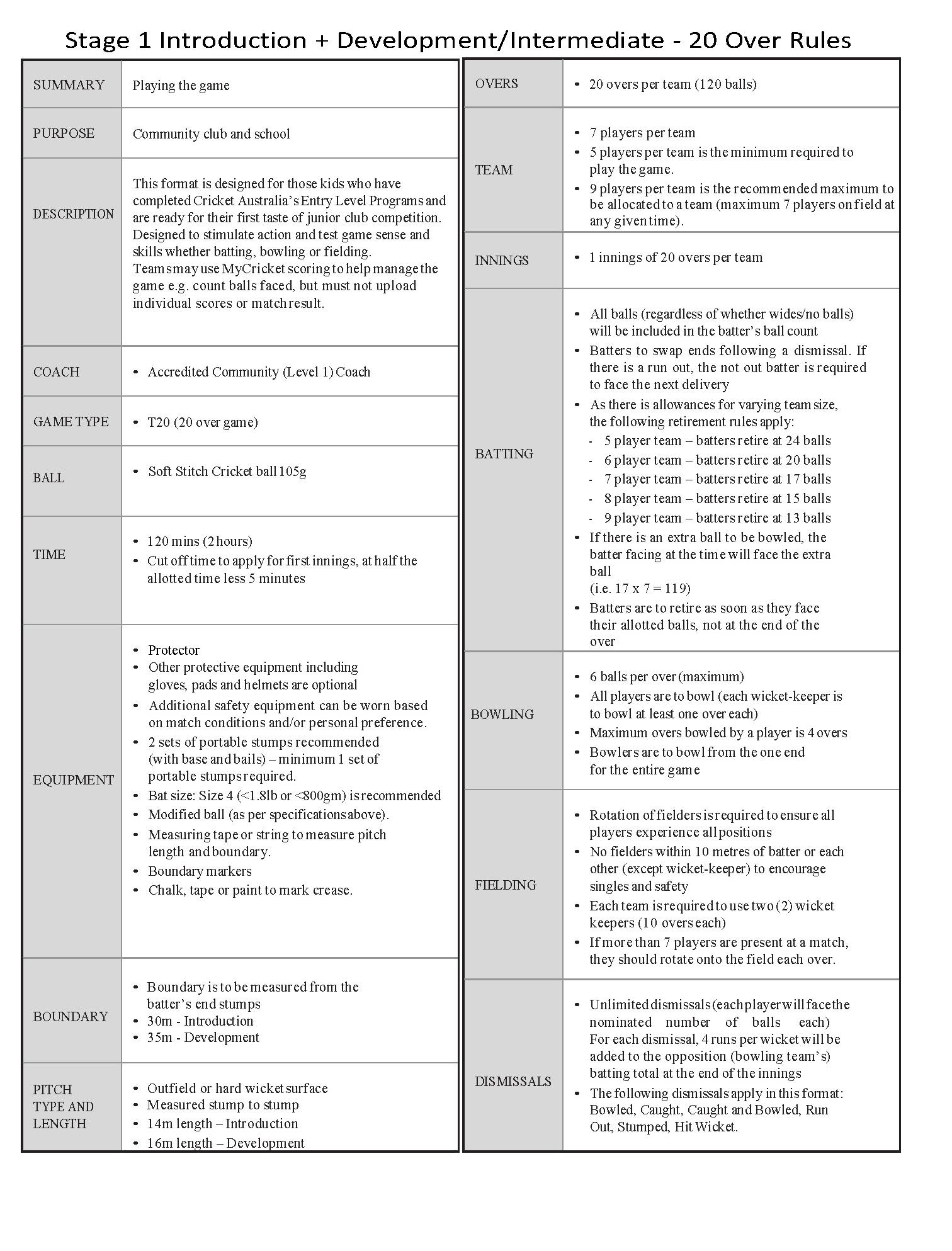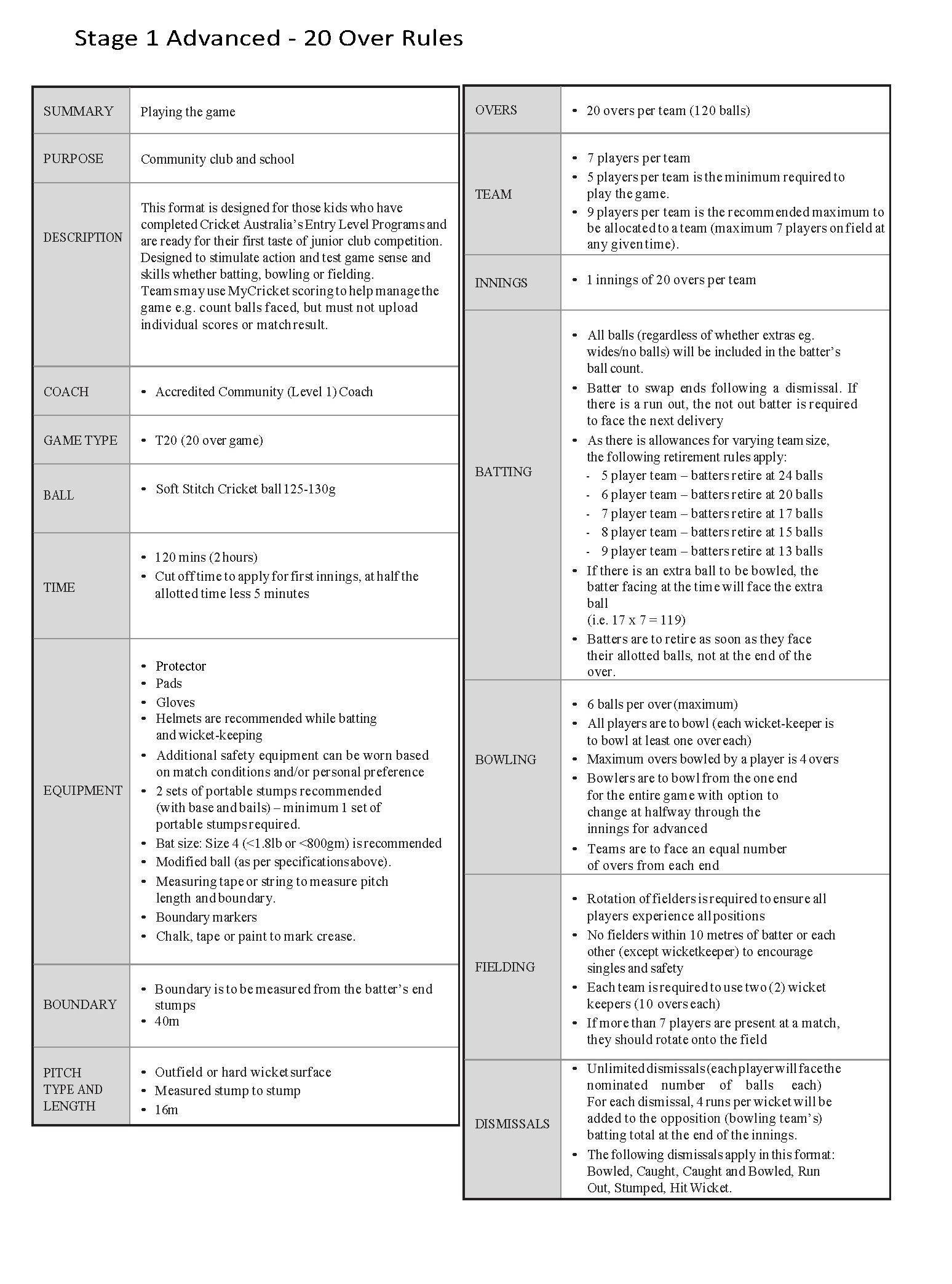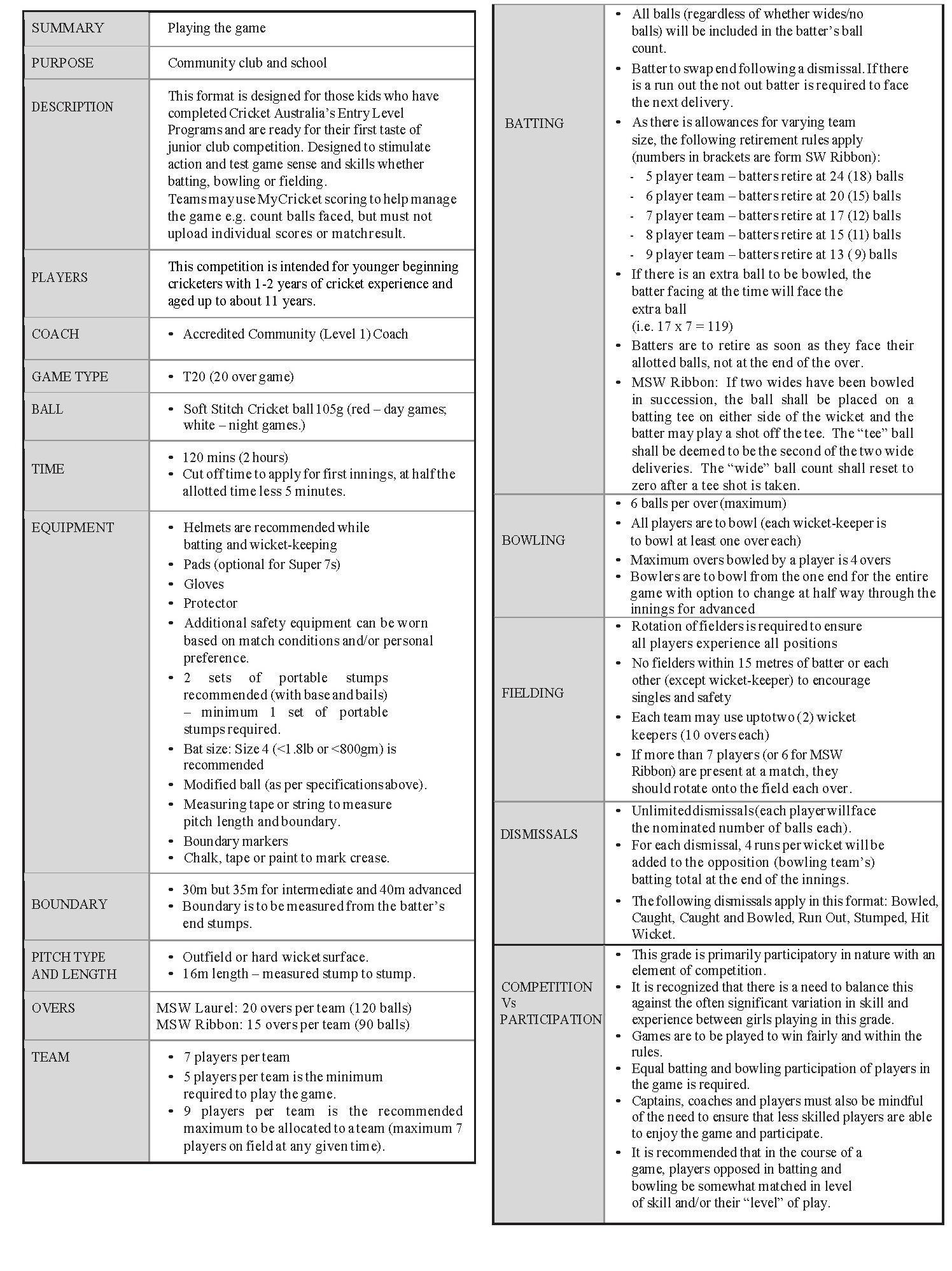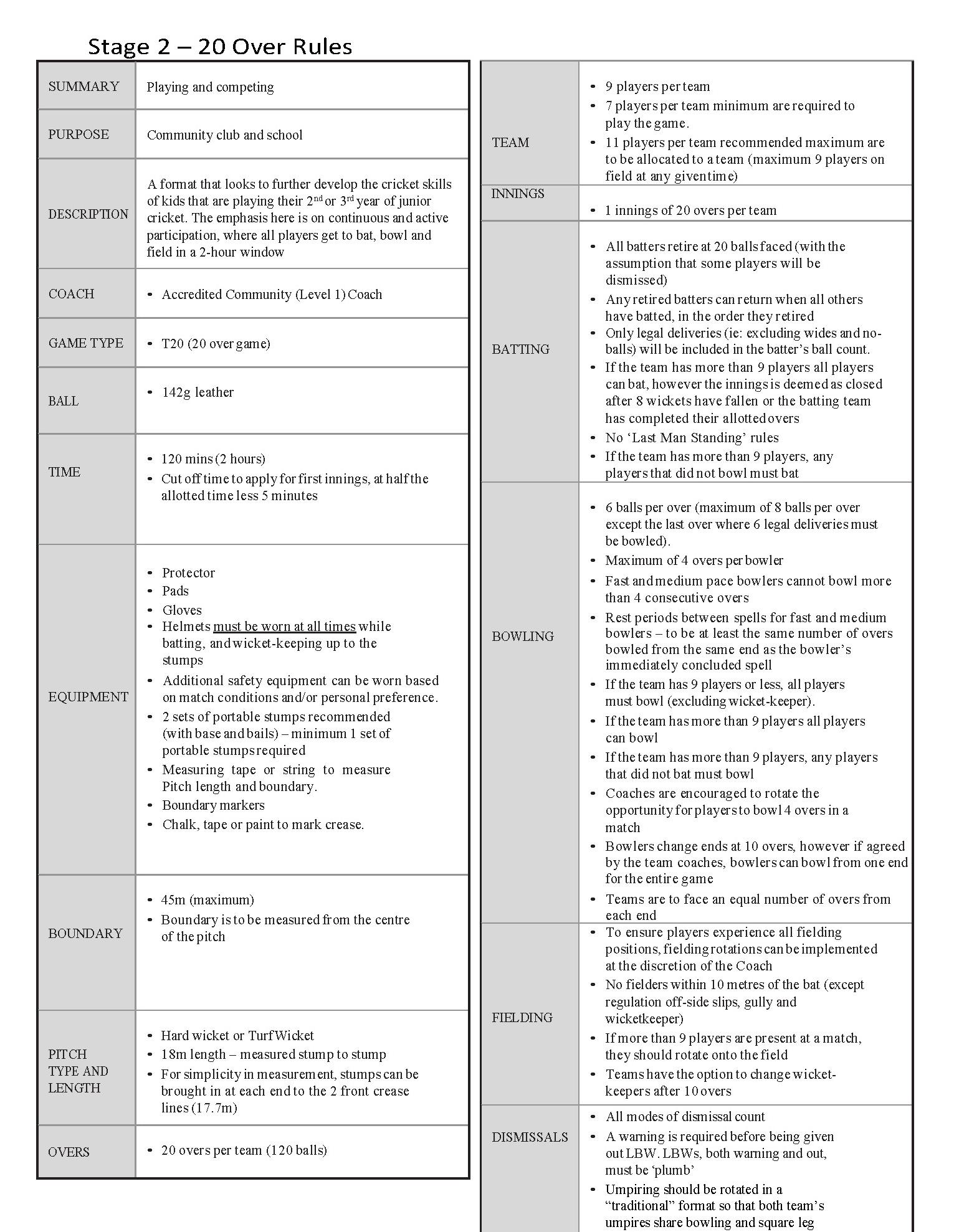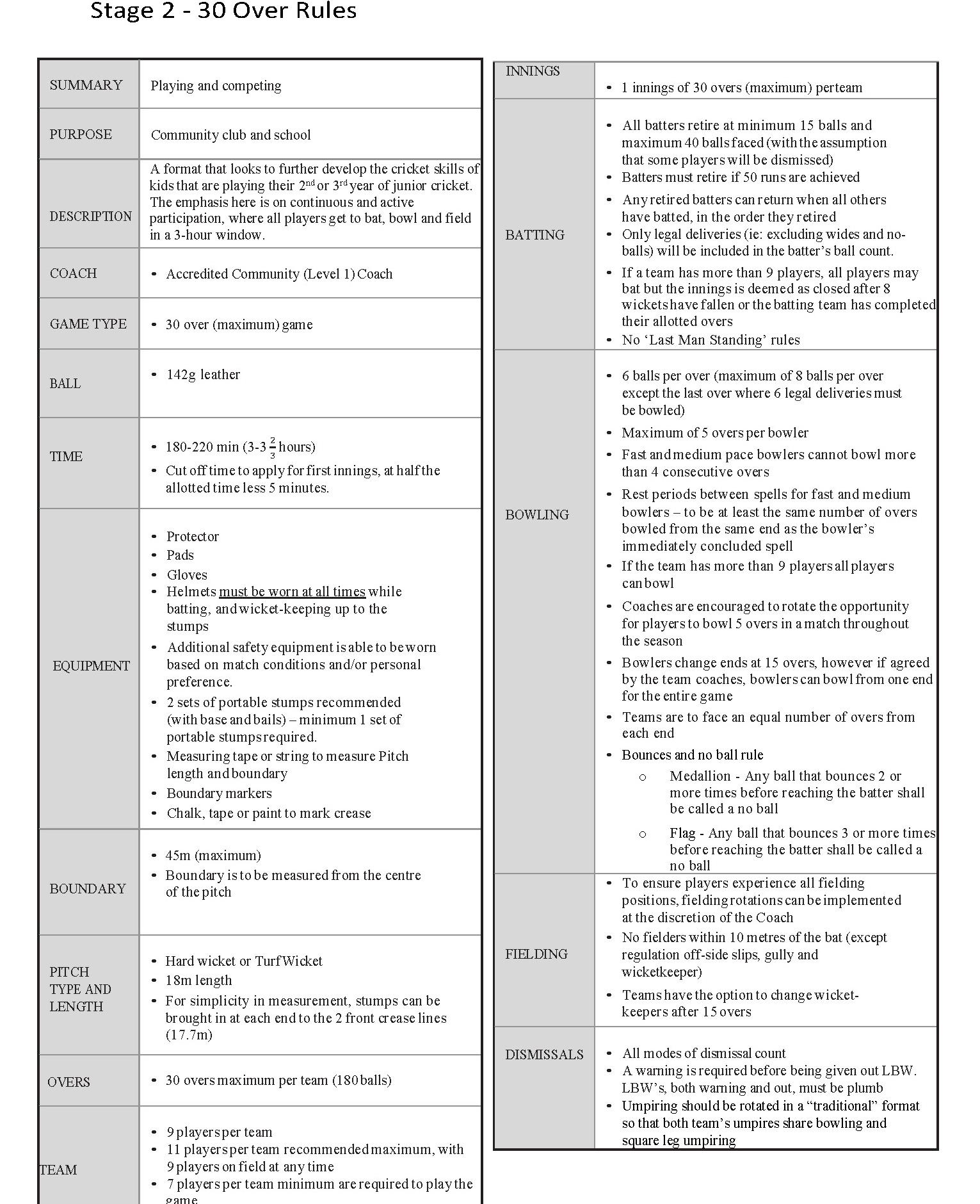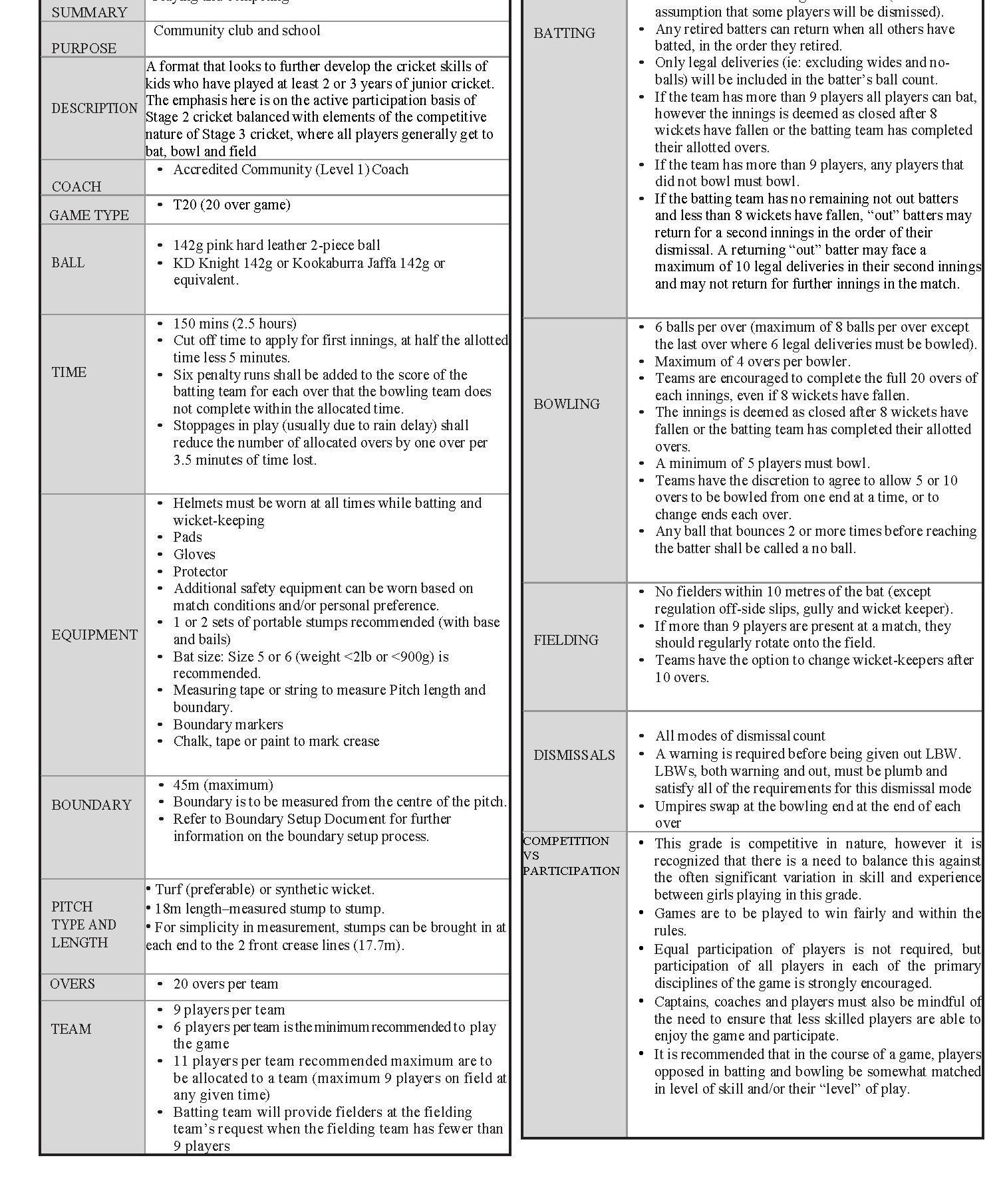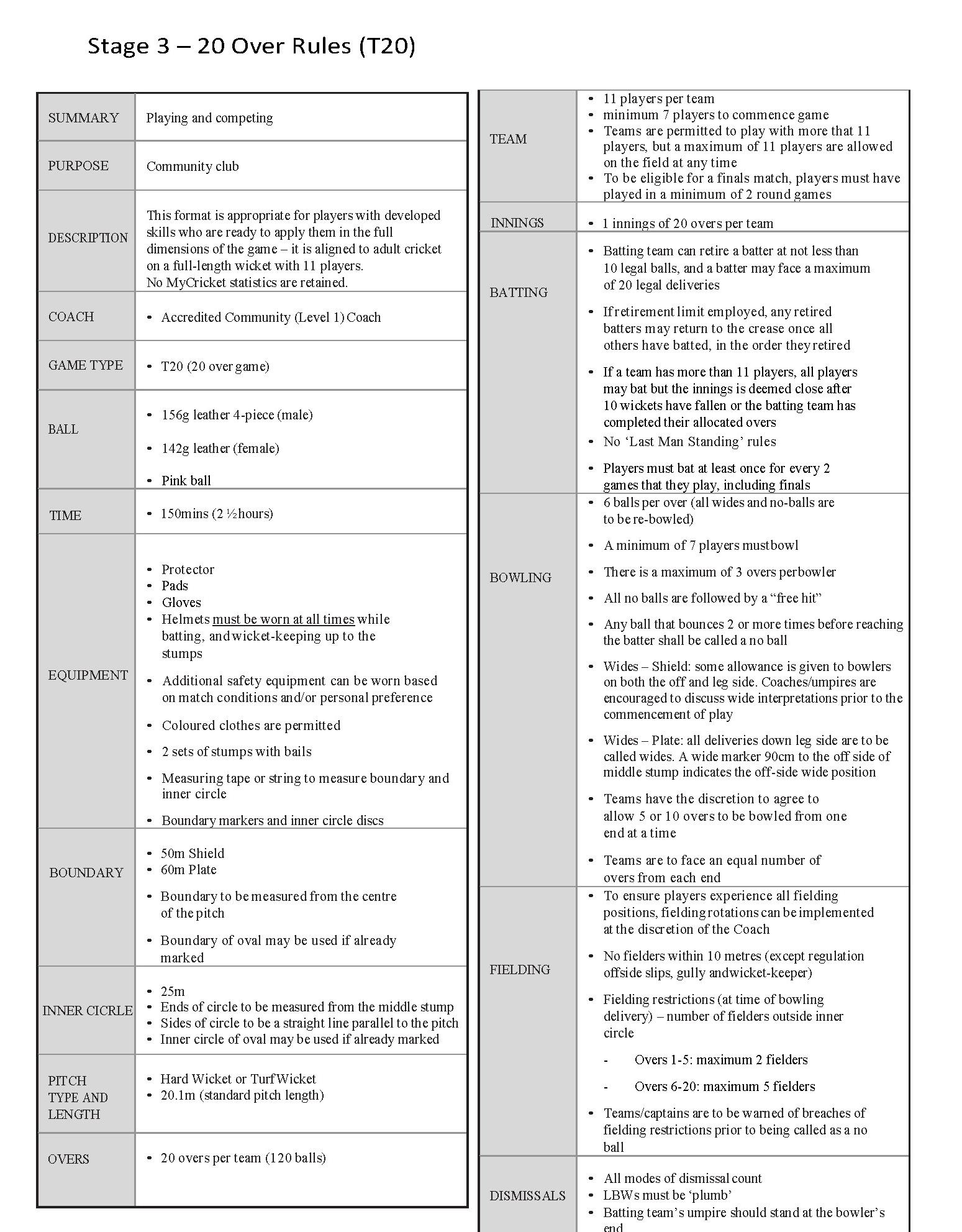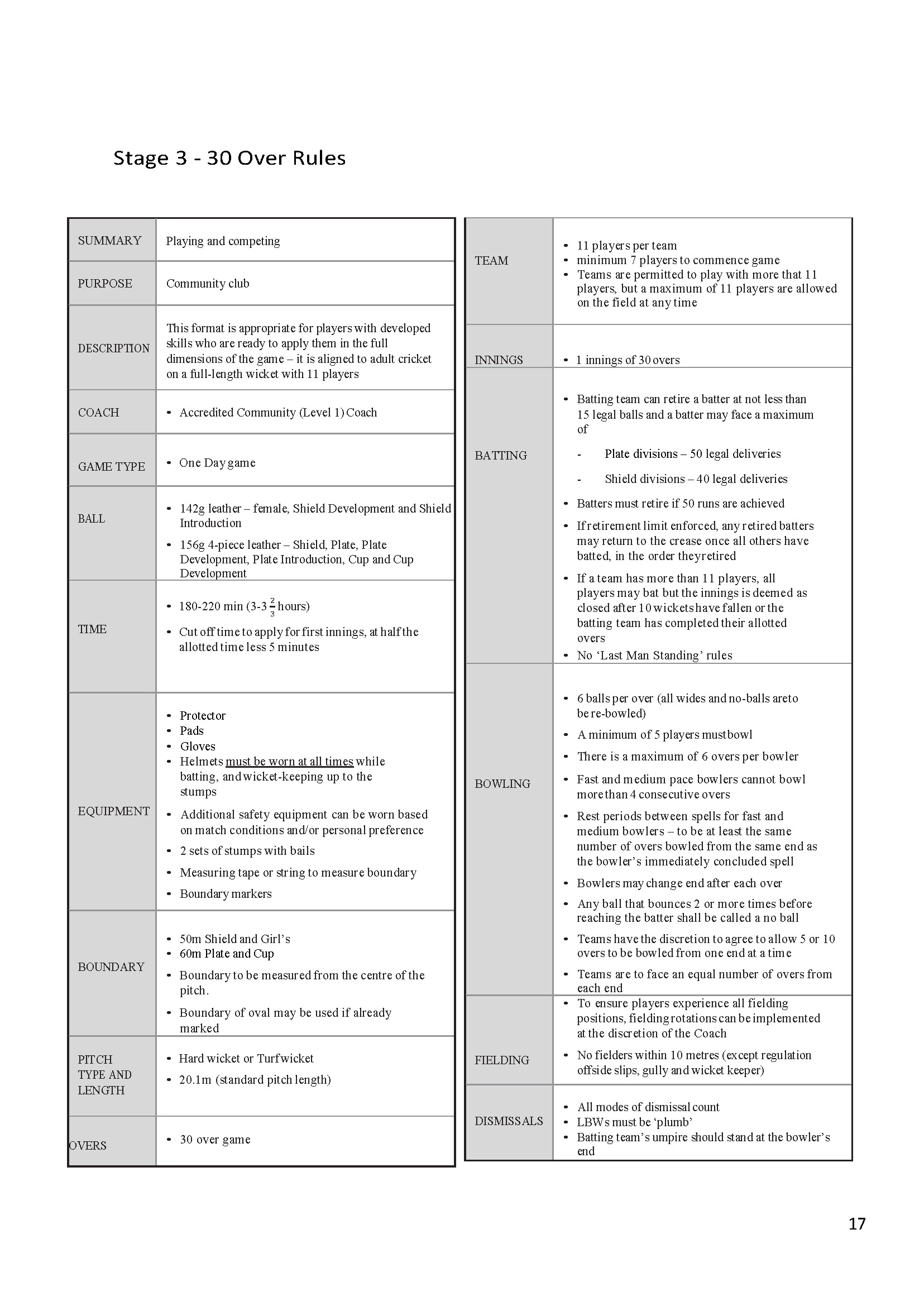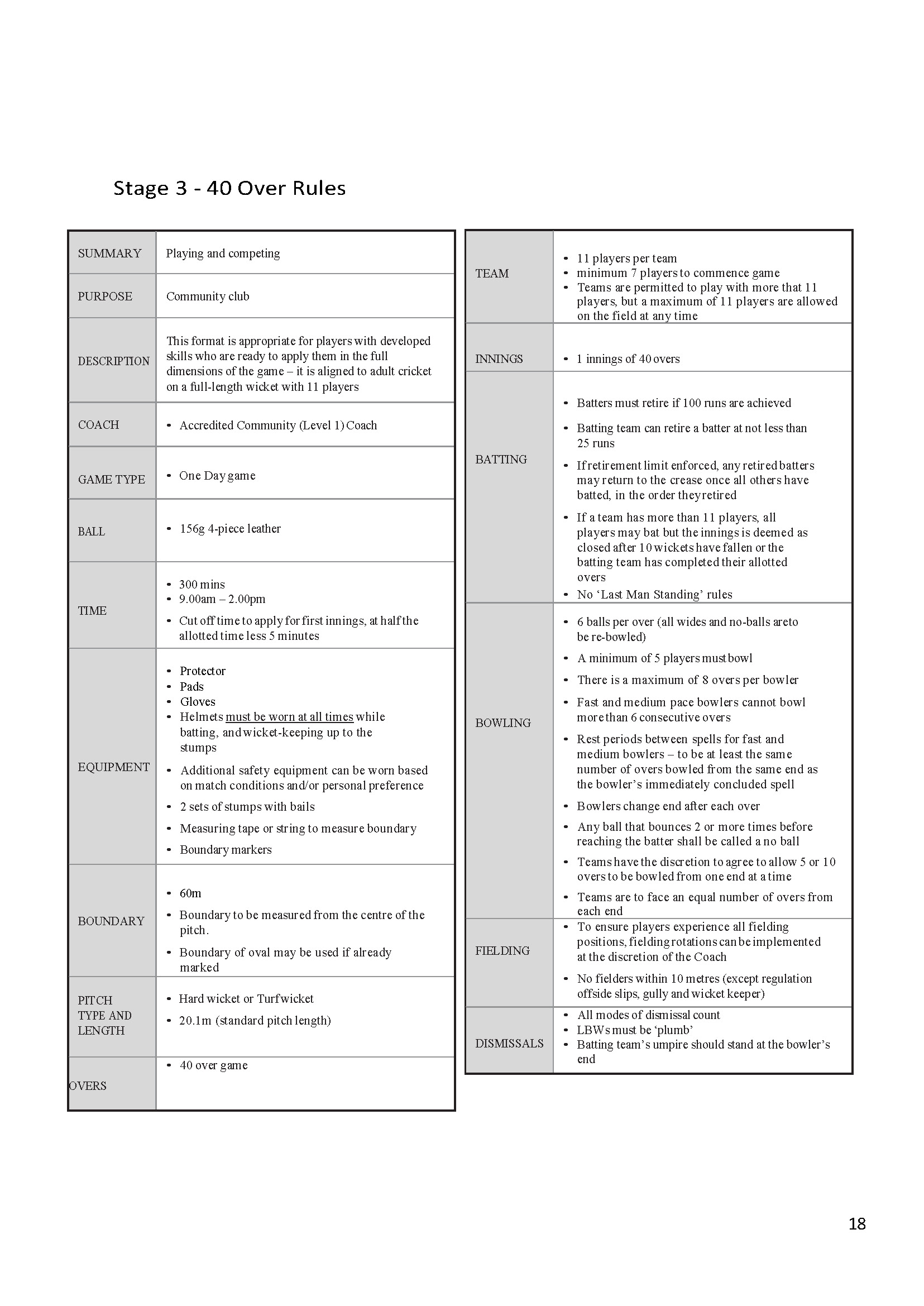One Day Rules:
Metropolitan South West District Cricket Inc.
Junior Cricket Rules
Cricket Blast to Stage 3
Updated: October 2021
Introduction
This document sets out the playing conditions, codes of behaviour and administrative rules for junior cricket in the Metropolitan South West District. The information applies to all junior cricket stages. Additional rules specific to particular junior stages from Cricket Blast to Stage 3 are attached.
• Cricket Blast (indicative age range 5-9)
• Stage 1 (indicative age range 8-11)
• Stage 2 (indicative age range 10-13)
• Stage 3 (indicative age range 12-17)
Queries
• Any queries should be directed to the MSW Secretary at secretary@mswcricket.com
Codes of Behaviour
Players
• Play by the rules.
• The umpire’s decision is final – respect all decisions and never argue with an official.
• Control your temper and remain calm – verbal abuse, sledging or deliberately distracting or provoking an opponent is unacceptable.
• Be a good sport – applaud all good plays whether they are your team’s or the opposition’s.
• Treat all players with respect – regardless of gender, ability, cultural background or religion.
• Work equally hard for yourself and your team.
• Cooperate with your captain, coach, manager, teammates and opponents.
• Have fun at all times – play to enjoy the game, not just to please others.
Coaches
• Remember that young people participate for pleasure – winning is only part of the fun.
• Compliment the performance of all children – never ridicule or yell at a child.
• Be reasonable in your demands on players’ time, energy and enthusiasm.
• Ensure all young people receive equal attention and playing opportunities.
• Abide by local conditions – encourage children to settle disagreements calmly.
• Ensure that equipment and facilities meet safety standards and are appropriate to the age and ability of all players.
• Control your temper and remain calm at all times – encourage players to do the same
• On-field coaching is encouraged in stage 1 cricket.
• Limited on-field coaching is permitted in stage 2 cricket.
• On-field or side-line coaching is not permitted in stage 3 cricket.
• Ensure any physical contact with a young person is appropriate and necessary.
• Treat all people with respect – regardless of gender, ability, cultural background or religion.
Parents and spectators
• Enjoy the game – remember that children participate in sport for their own enjoyment.
• Encourage children to participate – do not force them.
• Focus on the children’s efforts and performances rather than whether they win or lose.
• Respect the decisions and actions of all coaches, managers, captains and match officials.
• Encourage children to respect local conditions and settle disagreements calmly.
• Compliment the performance of all children – never ridicule or yell at a child.
• Lead by example and be a positive role model.
• Support efforts to remove verbal and physical abuse from sporting activities.
• Treat all people with respect – regardless of gender, ability, cultural background or religion.
Administrators
• Involve young people in planning, leadership, evaluation and decision-making.
• Create pathways for young people to participate in sport – not just as players but as a coaches, umpires and administrators.
• Ensure that rules and other processes suit the age, ability and maturity level of young players.
• Provide quality supervision and instruction for junior players.
• Remember that young people participate for pleasure – don’t over-emphasise awards.
• Encourage fair play – not winning at all costs.
• Help develop coaches and officials and help improve standards of coaching and officiating.
• Encourage spectators, officials, parents, coaches, players and the media to follow codes of behaviour.
• Ensure your behaviour and comments are positive and supportive.
• Make it clear that abusing young people in any way is unacceptable and will result in disciplinary action.
• Treat all people with respect – regardless of gender, ability, cultural background or religion.
Association rules
Membership and registration
• Clubs must be affiliated members of MSW Cricket prior to 31 October each season.
• Players must be registered by their clubs with MSW Cricket and Qld Junior Cricket.
• The Executive Committee of each club must hold registration certificates of all players in the club.
• To be eligible for MSW representative cricket teams, a player must be registered at a member club and (unless extenuating circumstances occur as approved by the Management Committee), play cricket matches for that MSW club during the season.
Age of players
• For MSW representative cricket, a player’s age must sit within the relevant age group on 31 August of the year the season commences.
• Age guidelines for stage cricket are indicative only. Stage cricket is based on player development and skill level.
Clothing and equipment
• All players must wear their club’s uniform.
• For red ball cricket, shirts, long trousers and shorts must be mainly white; any coloured apparel must be approved by the MSW management committee.
• For white/pink ball cricket, it is permissible, but not compulsory, to wear coloured clothing, consistent with the club’s uniform and at the option of the club (white clothing is acceptable).
• MSW’s approved ball supplier is Keith Dudgeon Cricket Specialists.
• Shoes must be ‘sports’ type, and some turf pitches require spiked shoes.
• Club caps or sun hats are mandatory when fielding (optional during night games).
• Applying plenty of sunscreen on exposed skin is recommended.
• It is mandatory that helmets in stage 2 and 3 are British Standard – BS7928:2013.
• It is the responsibility of the coach/umpire to ensure that helmets are worn when mandated. It is the responsibility of the player, parent or other guardian supplying the helmet, that it is British Standard.
Umpires
• Each team shall provide an official umpire and scorer.
• The umpire may be a parent with suitable knowledge of the rules and etiquette of the game – however, a parent should not officiate while their child is batting or bowling.
• Only one umpire from each team should officiate at any given time (except in extenuating circumstances and with the agreement of the opposing team).
• Stage 3 - recommended that the umpire from the batting team umpires from the bowler’s end, and that the bowler’s team umpire stands at square leg.
• Umpiring must be objective, unbiased and consistent between innings, particularly with respect to wide and no-balls.
• Electronic communication between the umpire and scorers or teams is prohibited.
Grounds
• A Game Day Checklist must be completed and signed by representatives of each team prior to play and held by each club for at least seven years – a copy can be downloaded from MSW at www.mswcricket.com or is available as a mobile app from
JLT Insurance.
• The safety of players is paramount – safety first, play second.
• Under no circumstances should a game be started if it is raining or showering.
• Play should only be suspended if conditions (eg. lightning, rain) make play dangerous
• If conditions do not improve after 40 minutes, play shall be suspended for the day and a draw recorded – no time shall be added for lost playing time.
• A decision on the fitness of the ground for play (or use of an alternative ground) must
be made by representatives from each team (preferably the coaches) and/or official umpires, in consultation with the club groundsman if applicable.
• If team representatives disagree about ground fitness or conditions, there will be no play and the game recorded as a draw.
• Changes to location and timing of scheduled matches must be approved by the MSW Management Committee.
Play
• Short-pitched deliveries:
• Stage 1, Stage 2 (Flag and Medallion) and Shield - slow or fast bowling, reaching the batter above shoulder height, when standing in a normal batting stance, shall be called a no ball.
• Plate – 1 short-pitched delivery (bouncer) is permitted to be bowled to each batter each over. Subsequent short-pitched deliveries will be called a no ball.
• Cup - 2 short-pitched delivery (bouncer) is permitted to be bowled to each batter each over. Subsequent short-pitched deliveries will be called a no ball.
• Any full-pitched delivery reaching the batter above waist height, when the batter is standing in an upright stance within the crease, shall be called no ball
• A full-pitched delivery, medium or fast, reaching the batter above waist height, and deemed dangerous by an umpire, will result in a 1st and final warning for the bowler. A 2nd infringement by the same bowler during the same innings will result in that
bowler being immediately withdrawn from bowling.
• Batting retirements are permitted either immediately after the relevant retirement criteria has been met. In stage 2 and 3, at the discretion of the batter and/or batting team coach, retirements can be delayed until the end of that over, but no later.
• If a ball landing on or off the synthetic pitch that behaves erratically in the opinion of the umpire (e.g. by hitting the edge of the pitch or a clump of grass), the umpire should declare the ball ‘dead’ and no additional runs are to be taken. However, if a ball hits the edge of the pitch and moves further wide, it is to be called wide.
• Under no circumstances is a batter permitted to switch-hit – defined as the batter changing stance from right-handed to left-handed (or vice versa) after the bowler has started their run-up.
• A dismissal by ‘Mankad’ is prohibited. Where the batter at the non-striker’s end is leading off excessively the umpire should remind the batter of their obligations.
• Teams playing 2-day, 2-innings cricket may declare their 1st and/or 2nd innings closed. If declarations are deemed to have been made to manufacture an outright result, the Management Committee reserves the right to deduct points from teams.
• Games in stage 3 where conditions have not allowed any play on day 1 of a 2-day game will be played as a 1 day games on the 2nd scheduled day of play.
• ½ day games - 30 over game using “Stage 3 - 30 Over Rules”
• Full day games – 40 over game using “Stage 3 – 40 Over Rules”
• Teams playing 2-day formats may substitute players between day 1 and day 2. These
players must be nominated before the toss at the start of the game on day 1.
• Detailed rules specific to different junior stages and types of cricket (e.g. T20) are attached – otherwise the normal rules of cricket apply as administered by the MCC.
Results
• Each team must keep an accurate scorebook. Electronic scoring is permitted, however, the use of one paper copy scorebook is recommended.
• At the end of the match, teams must agree on scores and the result.
• In the situation of time lost in a match, a result can be achieved if both sides have had the opportunity to face half the allotted overs for the game. If teams face an unequal number of overs (both receiving equal to or greater than half), then the result shall be determined based on the score at the end of the last full over received by the team receiving the lesser overs.
• Both teams must also enter the match result and individual scores into MyCricket, no later than midnight on the Wednesday after the game – failure to enter or confirm match results may incur a points penalty but only after notice in writing is given to the club involved and the results not entered within 7 days.
• For Stage 2 and 3, a ladder is maintained in MyCricket with points awarded as follows:
o 6 – win on 1st innings
o 10 - outright win after leading on 1st innings
o 6 – lose 1st innings, win outright
o 4 – win 1st innings, lose outright
o 3 - draw, tie, washout or abandoned game
o 6 - bye
o 0 - loss
• No bonus points are awarded.
• Where weather has impacted on the round of fixtures within a division, the round shall be declared entirely abandoned if 2 or more matches are abandoned. That is, all matches will be drawn. All teams, including any “bye” teams, will be awarded competition points for a draw.
• In competitions that have a final/s, qualification for the finals will be determined initially by competition points. In the event of points being equal, net run rate will be used.
• In Stage 1 cricket, MyCricket used offline can be helpful for match management to keep track of overs bowled and balls faced. Live scoring using MyCricket is not permitted in Stage 1 matches, even if the intent is to not upload scores at the end of the game.
Bad Weather
• Generally, when weather prevents play, every 6 minutes of lost time is considered to be 2 lost overs to the game. Unless by agreement between the coaches, abandoning play should be delayed as long as possible.
Breaks within matches
• An innings break of 10mins is allowed.
• Drinks breaks should be limited to 3 minutes and taken at approximately halfway through the innings of 20 and 30 over games. Games of 55 and 70 overs are to have 5-minute drinks breaks as specified in the relevant rules. Provision should be made for more frequent drinks breaks if conditions necessitate.
Forfeits
• A win by forfeit may be claimed if a team is unable to commence play within 15 minutes after the scheduled starting time. Maximum competition points for that game are awarded to the winning team.
• A waiting coach/manager may agree to time adjustments so that a game is played.
• Before claiming a forfeit, every attempt should be made to achieve a start of play.
Time and adjustments for slow over rates
• To maximise player participation, matches should be played for the full duration, e.g. a team batting second that passes the opposition’s score should bat out the full number of overs.
• If a team bowling first fails to complete the required number of overs by the end of the allotted time, then the number of overs in their batting innings will be restricted to the number they bowled.
• If a team bowling second fails to bowl the required number of overs in the allotted time, 6 penalty runs/over not bowled will be applied to the batting team’s total.
Compliance and disputes
• The rules in this document may not be varied by participants on or before game days without the approval of a member of the MSW management committee.
• Umpires, coaches and managers should intervene if MSW’s codes of behaviour are breached – for example, in instances of bad behaviour by spectators or offensive comments by players.
• If the matter cannot be settled between the clubs involved, a detailed written report must be submitted to the Secretary of MSW Cricket (secretary@mswcricket.com).
• The MSW management committee will investigate and make a determination.
• The MSW management committee reserves the right to suspend any player, official, other participant or other party from future matches.
• Appeals must be submitted in writing to the MSW Secretary no later than seven days after the match in question.
Girl’s cricket
Gender
• All players must be female.
• If a team is short of players, it is much preferred that batting teams loan players to the fielding team to make up the full complement of fielders. A team may (with the prior agreement of the team they are playing) include a boy in the team, however the boy may only field and must be of a similar skill level and age to the girls participating.
Age
• Player age is flexible for all stages.
• Players 18+ years old can play Stage 3, but must be not sufficiently skilled to regularly be selected for women’s grade cricket.
Clothing
• Team clothing in club colours (or at least a coloured shirt) is highly recommended. Otherwise, players must wear cricket whites and club caps or white cricket hats.
Finals Qualification
• Qualification for finals shall be determined by the teams points position on the competition latter at the conclusion of the preliminary rounds.
• Where teams are tied on points, their position shall be determined by net run rate. Teams which are bowled out for less than the allocated number of overs shall be deemed to have faced the allocated number of overs to calculate net run rate.
• Individual players must have played at least five games for a team to play for that team in the finals’ rounds. Exemptions may be granted by MSW under extenuating circumstances (eg: a player unable to play the preliminary rounds due to injury).
Finals Rounds Structure
(SF: Semi-final, GF: Grand-final, CF: Consolation-final, W/L: Winner/Loser)
Even number of teams:
• Semis: SF1: 1v4, SF2: 2v3, SF3: 5v8, SF4: 6v7.
• Finals: GF: W(SF1) v W(SF2); CF1: L(SF1) v L(SF2), CF2: W(SF3) v W(SF3), CF4:
L(SF1) v L(SF2)
Odd number of teams:
• Semis: SF1: 2v3, SF2: 4v5, BYE: 1st placed team (direct to final)
• Finals: GF: 1 v W(SF1); CF: L(SF1) v W(SF2); BYE: L(SF2)
Metropolitan South West District Cricket Inc.
Junior Cricket Rules
Cricket Blast to Stage 3
Updated: October 2021
Introduction
This document sets out the playing conditions, codes of behaviour and administrative rules for junior cricket in the Metropolitan South West District. The information applies to all junior cricket stages. Additional rules specific to particular junior stages from Cricket Blast to Stage 3 are attached.
• Cricket Blast (indicative age range 5-9)
• Stage 1 (indicative age range 8-11)
• Stage 2 (indicative age range 10-13)
• Stage 3 (indicative age range 12-17)
Queries
• Any queries should be directed to the MSW Secretary at secretary@mswcricket.com
Codes of Behaviour
Players
• Play by the rules.
• The umpire’s decision is final – respect all decisions and never argue with an official.
• Control your temper and remain calm – verbal abuse, sledging or deliberately distracting or provoking an opponent is unacceptable.
• Be a good sport – applaud all good plays whether they are your team’s or the opposition’s.
• Treat all players with respect – regardless of gender, ability, cultural background or religion.
• Work equally hard for yourself and your team.
• Cooperate with your captain, coach, manager, teammates and opponents.
• Have fun at all times – play to enjoy the game, not just to please others.
Coaches
• Remember that young people participate for pleasure – winning is only part of the fun.
• Compliment the performance of all children – never ridicule or yell at a child.
• Be reasonable in your demands on players’ time, energy and enthusiasm.
• Ensure all young people receive equal attention and playing opportunities.
• Abide by local conditions – encourage children to settle disagreements calmly.
• Ensure that equipment and facilities meet safety standards and are appropriate to the age and ability of all players.
• Control your temper and remain calm at all times – encourage players to do the same
• On-field coaching is encouraged in stage 1 cricket.
• Limited on-field coaching is permitted in stage 2 cricket.
• On-field or side-line coaching is not permitted in stage 3 cricket.
• Ensure any physical contact with a young person is appropriate and necessary.
• Treat all people with respect – regardless of gender, ability, cultural background or religion.
Parents and spectators
• Enjoy the game – remember that children participate in sport for their own enjoyment.
• Encourage children to participate – do not force them.
• Focus on the children’s efforts and performances rather than whether they win or lose.
• Respect the decisions and actions of all coaches, managers, captains and match officials.
• Encourage children to respect local conditions and settle disagreements calmly.
• Compliment the performance of all children – never ridicule or yell at a child.
• Lead by example and be a positive role model.
• Support efforts to remove verbal and physical abuse from sporting activities.
• Treat all people with respect – regardless of gender, ability, cultural background or religion.
Administrators
• Involve young people in planning, leadership, evaluation and decision-making.
• Create pathways for young people to participate in sport – not just as players but as a coaches, umpires and administrators.
• Ensure that rules and other processes suit the age, ability and maturity level of young players.
• Provide quality supervision and instruction for junior players.
• Remember that young people participate for pleasure – don’t over-emphasise awards.
• Encourage fair play – not winning at all costs.
• Help develop coaches and officials and help improve standards of coaching and officiating.
• Encourage spectators, officials, parents, coaches, players and the media to follow codes of behaviour.
• Ensure your behaviour and comments are positive and supportive.
• Make it clear that abusing young people in any way is unacceptable and will result in disciplinary action.
• Treat all people with respect – regardless of gender, ability, cultural background or religion.
Association rules
Membership and registration
• Clubs must be affiliated members of MSW Cricket prior to 31 October each season.
• Players must be registered by their clubs with MSW Cricket and Qld Junior Cricket.
• The Executive Committee of each club must hold registration certificates of all players in the club.
• To be eligible for MSW representative cricket teams, a player must be registered at a member club and (unless extenuating circumstances occur as approved by the Management Committee), play cricket matches for that MSW club during the season.
Age of players
• For MSW representative cricket, a player’s age must sit within the relevant age group on 31 August of the year the season commences.
• Age guidelines for stage cricket are indicative only. Stage cricket is based on player development and skill level.
Clothing and equipment
• All players must wear their club’s uniform.
• For red ball cricket, shirts, long trousers and shorts must be mainly white; any coloured apparel must be approved by the MSW management committee.
• For white/pink ball cricket, it is permissible, but not compulsory, to wear coloured clothing, consistent with the club’s uniform and at the option of the club (white clothing is acceptable).
• MSW’s approved ball supplier is Keith Dudgeon Cricket Specialists.
• Shoes must be ‘sports’ type, and some turf pitches require spiked shoes.
• Club caps or sun hats are mandatory when fielding (optional during night games).
• Applying plenty of sunscreen on exposed skin is recommended.
• It is mandatory that helmets in stage 2 and 3 are British Standard – BS7928:2013.
• It is the responsibility of the coach/umpire to ensure that helmets are worn when mandated. It is the responsibility of the player, parent or other guardian supplying the helmet, that it is British Standard.
Umpires
• Each team shall provide an official umpire and scorer.
• The umpire may be a parent with suitable knowledge of the rules and etiquette of the game – however, a parent should not officiate while their child is batting or bowling.
• Only one umpire from each team should officiate at any given time (except in extenuating circumstances and with the agreement of the opposing team).
• Stage 3 - recommended that the umpire from the batting team umpires from the bowler’s end, and that the bowler’s team umpire stands at square leg.
• Umpiring must be objective, unbiased and consistent between innings, particularly with respect to wide and no-balls.
• Electronic communication between the umpire and scorers or teams is prohibited.
Grounds
• A Game Day Checklist must be completed and signed by representatives of each team prior to play and held by each club for at least seven years – a copy can be downloaded from MSW at www.mswcricket.com or is available as a mobile app from
JLT Insurance.
• The safety of players is paramount – safety first, play second.
• Under no circumstances should a game be started if it is raining or showering.
• Play should only be suspended if conditions (eg. lightning, rain) make play dangerous
• If conditions do not improve after 40 minutes, play shall be suspended for the day and a draw recorded – no time shall be added for lost playing time.
• A decision on the fitness of the ground for play (or use of an alternative ground) must
be made by representatives from each team (preferably the coaches) and/or official umpires, in consultation with the club groundsman if applicable.
• If team representatives disagree about ground fitness or conditions, there will be no play and the game recorded as a draw.
• Changes to location and timing of scheduled matches must be approved by the MSW Management Committee.
Play
• Short-pitched deliveries:
• Stage 1, Stage 2 (Flag and Medallion) and Shield - slow or fast bowling, reaching the batter above shoulder height, when standing in a normal batting stance, shall be called a no ball.
• Plate – 1 short-pitched delivery (bouncer) is permitted to be bowled to each batter each over. Subsequent short-pitched deliveries will be called a no ball.
• Cup - 2 short-pitched delivery (bouncer) is permitted to be bowled to each batter each over. Subsequent short-pitched deliveries will be called a no ball.
• Any full-pitched delivery reaching the batter above waist height, when the batter is standing in an upright stance within the crease, shall be called no ball
• A full-pitched delivery, medium or fast, reaching the batter above waist height, and deemed dangerous by an umpire, will result in a 1st and final warning for the bowler. A 2nd infringement by the same bowler during the same innings will result in that
bowler being immediately withdrawn from bowling.
• Batting retirements are permitted either immediately after the relevant retirement criteria has been met. In stage 2 and 3, at the discretion of the batter and/or batting team coach, retirements can be delayed until the end of that over, but no later.
• If a ball landing on or off the synthetic pitch that behaves erratically in the opinion of the umpire (e.g. by hitting the edge of the pitch or a clump of grass), the umpire should declare the ball ‘dead’ and no additional runs are to be taken. However, if a ball hits the edge of the pitch and moves further wide, it is to be called wide.
• Under no circumstances is a batter permitted to switch-hit – defined as the batter changing stance from right-handed to left-handed (or vice versa) after the bowler has started their run-up.
• A dismissal by ‘Mankad’ is prohibited. Where the batter at the non-striker’s end is leading off excessively the umpire should remind the batter of their obligations.
• Teams playing 2-day, 2-innings cricket may declare their 1st and/or 2nd innings closed. If declarations are deemed to have been made to manufacture an outright result, the Management Committee reserves the right to deduct points from teams.
• Games in stage 3 where conditions have not allowed any play on day 1 of a 2-day game will be played as a 1 day games on the 2nd scheduled day of play.
• ½ day games - 30 over game using “Stage 3 - 30 Over Rules”
• Full day games – 40 over game using “Stage 3 – 40 Over Rules”
• Teams playing 2-day formats may substitute players between day 1 and day 2. These
players must be nominated before the toss at the start of the game on day 1.
• Detailed rules specific to different junior stages and types of cricket (e.g. T20) are attached – otherwise the normal rules of cricket apply as administered by the MCC.
Results
• Each team must keep an accurate scorebook. Electronic scoring is permitted, however, the use of one paper copy scorebook is recommended.
• At the end of the match, teams must agree on scores and the result.
• In the situation of time lost in a match, a result can be achieved if both sides have had the opportunity to face half the allotted overs for the game. If teams face an unequal number of overs (both receiving equal to or greater than half), then the result shall be determined based on the score at the end of the last full over received by the team receiving the lesser overs.
• Both teams must also enter the match result and individual scores into MyCricket, no later than midnight on the Wednesday after the game – failure to enter or confirm match results may incur a points penalty but only after notice in writing is given to the club involved and the results not entered within 7 days.
• For Stage 2 and 3, a ladder is maintained in MyCricket with points awarded as follows:
o 6 – win on 1st innings
o 10 - outright win after leading on 1st innings
o 6 – lose 1st innings, win outright
o 4 – win 1st innings, lose outright
o 3 - draw, tie, washout or abandoned game
o 6 - bye
o 0 - loss
• No bonus points are awarded.
• Where weather has impacted on the round of fixtures within a division, the round shall be declared entirely abandoned if 2 or more matches are abandoned. That is, all matches will be drawn. All teams, including any “bye” teams, will be awarded competition points for a draw.
• In competitions that have a final/s, qualification for the finals will be determined initially by competition points. In the event of points being equal, net run rate will be used.
• In Stage 1 cricket, MyCricket used offline can be helpful for match management to keep track of overs bowled and balls faced. Live scoring using MyCricket is not permitted in Stage 1 matches, even if the intent is to not upload scores at the end of the game.
Bad Weather
• Generally, when weather prevents play, every 6 minutes of lost time is considered to be 2 lost overs to the game. Unless by agreement between the coaches, abandoning play should be delayed as long as possible.
Breaks within matches
• An innings break of 10mins is allowed.
• Drinks breaks should be limited to 3 minutes and taken at approximately halfway through the innings of 20 and 30 over games. Games of 55 and 70 overs are to have 5-minute drinks breaks as specified in the relevant rules. Provision should be made for more frequent drinks breaks if conditions necessitate.
Forfeits
• A win by forfeit may be claimed if a team is unable to commence play within 15 minutes after the scheduled starting time. Maximum competition points for that game are awarded to the winning team.
• A waiting coach/manager may agree to time adjustments so that a game is played.
• Before claiming a forfeit, every attempt should be made to achieve a start of play.
Time and adjustments for slow over rates
• To maximise player participation, matches should be played for the full duration, e.g. a team batting second that passes the opposition’s score should bat out the full number of overs.
• If a team bowling first fails to complete the required number of overs by the end of the allotted time, then the number of overs in their batting innings will be restricted to the number they bowled.
• If a team bowling second fails to bowl the required number of overs in the allotted time, 6 penalty runs/over not bowled will be applied to the batting team’s total.
Compliance and disputes
• The rules in this document may not be varied by participants on or before game days without the approval of a member of the MSW management committee.
• Umpires, coaches and managers should intervene if MSW’s codes of behaviour are breached – for example, in instances of bad behaviour by spectators or offensive comments by players.
• If the matter cannot be settled between the clubs involved, a detailed written report must be submitted to the Secretary of MSW Cricket (secretary@mswcricket.com).
• The MSW management committee will investigate and make a determination.
• The MSW management committee reserves the right to suspend any player, official, other participant or other party from future matches.
• Appeals must be submitted in writing to the MSW Secretary no later than seven days after the match in question.
Girl’s cricket
Gender
• All players must be female.
• If a team is short of players, it is much preferred that batting teams loan players to the fielding team to make up the full complement of fielders. A team may (with the prior agreement of the team they are playing) include a boy in the team, however the boy may only field and must be of a similar skill level and age to the girls participating.
Age
• Player age is flexible for all stages.
• Players 18+ years old can play Stage 3, but must be not sufficiently skilled to regularly be selected for women’s grade cricket.
Clothing
• Team clothing in club colours (or at least a coloured shirt) is highly recommended. Otherwise, players must wear cricket whites and club caps or white cricket hats.
Finals Qualification
• Qualification for finals shall be determined by the teams points position on the competition latter at the conclusion of the preliminary rounds.
• Where teams are tied on points, their position shall be determined by net run rate. Teams which are bowled out for less than the allocated number of overs shall be deemed to have faced the allocated number of overs to calculate net run rate.
• Individual players must have played at least five games for a team to play for that team in the finals’ rounds. Exemptions may be granted by MSW under extenuating circumstances (eg: a player unable to play the preliminary rounds due to injury).
Finals Rounds Structure
(SF: Semi-final, GF: Grand-final, CF: Consolation-final, W/L: Winner/Loser)
Even number of teams:
• Semis: SF1: 1v4, SF2: 2v3, SF3: 5v8, SF4: 6v7.
• Finals: GF: W(SF1) v W(SF2); CF1: L(SF1) v L(SF2), CF2: W(SF3) v W(SF3), CF4:
L(SF1) v L(SF2)
Odd number of teams:
• Semis: SF1: 2v3, SF2: 4v5, BYE: 1st placed team (direct to final)
• Finals: GF: 1 v W(SF1); CF: L(SF1) v W(SF2); BYE: L(SF2)
